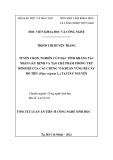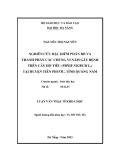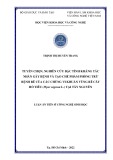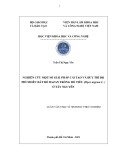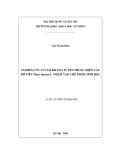
JST: Engineering and Technology for Sustainable Development
Volume 35, Issue 1, March 2025, 032-043
32
Development of Odor Lexicons for Black Pepper Grown
in Some Provinces in Vietnam
Tran Thi Thanh Hoa1, Le Tuan Phuc1, Pham Ngoc Hung1, Lai Quoc Dat2,
Hoang Quoc Tuan1, Cung Thi To Quynh1, Nguyen Hoang Dzung2*
1School of Chemistry and Life Sciences, Hanoi University of Science and Technology, Ha Noi, Vietnam
2Ho Chi Minh City University of Technology, Ho Chi Minh City, Vietnam
*Corresponding author email: dzung@hcmut.edu.vn
Abstract
Pepper (Piper nigrum L.) is a major crop in Vietnam, serving as a primary export commodity and contributing
significantly to the country's economic value. Despite being the world's leading producer and exporter of
pepper, its production still faces numerous limitations, instability, and lacks sustainability, partly attributed to
poor quality management, absence of branding, food adulteration, etc. Therefore, the aim of this study is to
develop a lexicon of odor descriptors contributing to the identification of characteristic properties of pepper
from different growing regions, evaluating the quality of pepper, and constructing the brand attributes of
Vietnamese pepper. A panel of 10 individuals, selected and screened, participated in the process of
constructing the lexicon of odor descriptors. Through three sessions of term reduction and two group
discussion sessions on definitions and references, a list comprising 11 odor descriptors was condensed from
an initial list of 33 terms. The final lexicon consists of 11 odor characteristic descriptions of pepper, each
accompanied by a definition and reference agreed upon by the entire panel. This lexicon demonstrates the
ability to differentiate pepper samples from various growing regions. Additionally, throughout the lexicon
development process, the panel also exhibited significant improvements in the ability to recognize and employ
terminology to describe the odor characteristics of pepper.
Keywords: Piper nigrum L., black pepper, odor, lexicons development.
1. Introduction*
Pepper is a major crop and a key export
commodity for Vietnam, generating significant
economic value and contributing to the growth of the
national, regional, and local economies. Vietnam has
maintained its position as the world's largest producer
and exporter of pepper since 2001. Vietnam's pepper
production accounts for over 40% of global production
and nearly 60% of the global pepper export market.
Notably, 95% of Vietnam's pepper output is destined
for export, while the remaining 5% is consumed
domestically (according to General Statistics Office of
Vietnam). Despite holding the top position globally,
pepper production in Vietnam faces several
challenges, including instability, lack of sustainability,
and quality management issues. These limitations are
partly attributed to factors such as the absence of a
strong brand identity and food fraud [1, 2].
With Vietnamese pepper reaching over
110 countries worldwide, fierce competition in terms
of price and quality has emerged from other
pepper-producing nations. Against this backdrop,
asserting the quality and value of Vietnamese pepper
in the international market is of paramount importance.
ISSN 2734-9381
https://doi.org/10.51316/jst.180.etsd.2025.35.1.5
Received: Aug 21, 2024 ; revised: Sep 9, 2024
accepted: Sep 25, 2024
Essential oil plays a crucial role in determining
the quality of black peppercorns. Researchers have
documented significant variations in the chemical
composition of black pepper essential oil, attributed to
factors such as cultivar differences, geographical
origin, raw material maturation stage, oil extraction
processes, identification methods, and preparation
method [3]. Over 80 components have been identified
in black pepper essential oil, with key constituents
including monoterpene hydrocarbons and oxygenated
monoterpenoids, sesquiterpene hydrocarbons and
oxygenated sesquiterpenes, and phenolic compounds
[4]. The major compounds found in black pepper are
germacrene D (11.01%), limonene (10.26%), β-pinene
(10.02%), α-phellandrene (8.56%), β-caryophyllene
(7.29%), α-pinen (6.40%), and cis-β-ocimene (3.19%).
The primary contributors to the characteristic odor of
black pepper are believed to be the following
compounds: sabinene, β-pinene, α-phellandrene,
δ-carene, β-phellandrene, limonene, isoborneol,
β-caryophyllene, α-guaiene, α-humulene, sarisan,
germacrene D, elemicin, calamenene, caryophyllene
alcohol, isoelemicin, T-muurolol, cubenol, and
bulnesol [5].



















